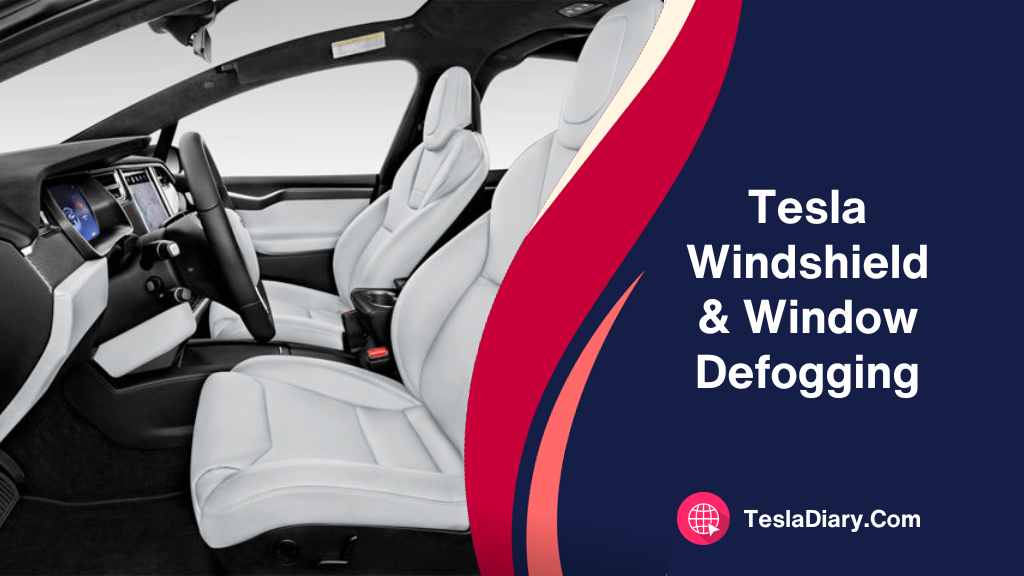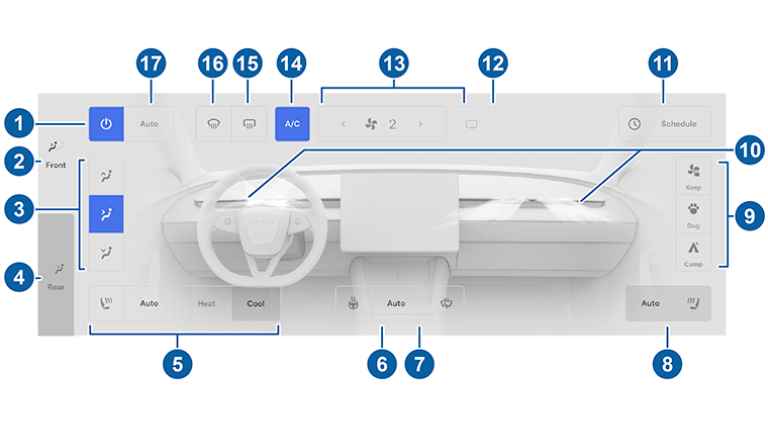Picture this: you’re behind the wheel of your sleek, high-tech Tesla, ready to conquer the road. But then, you encounter an unexpected obstacle—your windshield is mysteriously shrouded in a veil of fog.
It’s a scenario that any Tesla driver can face, and it’s not just an inconvenience; it’s a potential safety hazard.
In this article, we dive deep into the enigmatic world of the Tesla foggy windshield issue, uncovering its root causes and unveiling the secrets to restoring clarity to your driving experience.
So, fasten your seatbelt as we demystify the foggy Tesla windshield problem and show you how to conquer it with confidence.

Common Causes of a Foggy Windshield
Understanding the reasons behind a foggy windshield is crucial for finding the right solution. Several factors can contribute to this issue:
1. Interior Moisture
Condensation on the inside of your windshield is a prevalent cause of fogging. It occurs when warm, moisture-laden air inside your car comes into contact with the cooler surface of the windshield, causing the moisture to condense. Several sources contribute to interior moisture:
Breathing:
As you and your passengers breathe, you release warm, moist air into the cabin. When this air contacts the cold windshield, it can lead to condensation.
Wet Clothing and Items:
Bringing wet clothing, umbrellas, or other damp items into your car can introduce excess moisture into the cabin.
Spilled Drinks:
Any liquid spills inside the car can increase humidity levels, contributing to condensation on the windshield.
2. Weather Conditions
The weather plays a substantial role in causing windshield fogging:
Cold Weather:
When the outside temperature is significantly colder than the interior temperature of your Tesla, moisture inside the vehicle can easily condense on the glass. This is a common occurrence during colder months, especially in regions with cold winters.
Humid Conditions:
High humidity levels in the air can also lead to foggy windows, particularly during rainy or foggy weather. The moisture-laden air inside the cabin can condense on the windshield, obstructing your view.
3. HVAC System Issues
Your Tesla’s heating, ventilation, and air conditioning (HVAC) system plays a crucial role in preventing windshield fogging. However, certain issues can affect its performance:
Improper Settings:
Incorrectly configured HVAC settings can lead to inadequate defrosting or dehumidifying of the interior air. If your HVAC settings are not aligned with the prevailing weather conditions, it can result in foggy windshields.
Clogged Filters:
Cabin air filters in your Tesla can become dirty or clogged over time. A dirty filter reduces the airflow through the HVAC system, affecting its ability to manage moisture and maintain a clear windshield.
How to Defog Windshield in Your Tesla
Now that we’ve identified the potential causes, let’s discuss how to fix a foggy windshield in your Tesla in detail:
1. Adjust HVAC Settings
Ensuring that your Tesla’s HVAC settings are appropriate for the weather conditions is crucial. Here’s how to do it:
Tesla Defog Mode:
Use the defog mode to clear condensation and defrost mode to clear ice from the windshield. This mode directs warm air to the windshield, helping to clear fog and frost quickly.
Here’s how you can use Tesla defog mode-
- Click on Temperature on touchscreen to open Climate Settings.
- Use the defog / defrost button on the left of the A/C button.
- Touch once on the button for defogging and twice for defrosting.

The arc-shaped button is for the windshield defogger and the squarer button is for rear windows defogging.
Set Temperature:
Adjust the temperature to maintain a comfortable cabin climate. A comfortable temperature reduces the chances of interior moisture condensing on the glass.
Circulate Air:
Turn on the air circulation feature to help remove excess moisture from the interior. Circulating air can help prevent the buildup of moisture inside the cabin.
Use the Number 3 buttons on the image above to customize air circulation according to your preference.
2. Use the AC System
Engaging the air conditioning (AC) system can help dehumidify the interior air and prevent condensation. Even in colder weather, running the AC for a short time can be effective in reducing fog. Here’s how to use the AC system effectively:
Select AC Mode: Ensure that the AC mode is turned on, even in cold weather. This helps to dehumidify the air inside the car.
Recirculate Air: When using the AC, switch to recirculate mode to maintain the desired cabin temperature more efficiently.
Monitor Moisture: Pay attention to the moisture level inside the cabin. Adjust the AC settings as needed to maintain a dry interior.
3. Keep Windows Slightly Open
Cracking your windows slightly can help improve air circulation, reducing interior moisture levels and preventing foggy windshields. Here’s how to do it safely:
Ventilation: Open the windows just a crack to allow fresh air to enter the cabin. This promotes better airflow and reduces humidity levels.
Monitor Weather: Be mindful of external weather conditions. Avoid leaving windows open during heavy rain or snow to prevent water from entering the car.
4. Replace Cabin Air Filters
Regularly check and replace the cabin air filters in your Tesla. Dirty or clogged filters can impair the HVAC system’s performance and contribute to foggy windows. Here’s how to maintain your cabin air filters:
Replace Filters in Time: According to Tesla, you need to replace your cabin air filters every couple of years in the United States, Canada, EU, and UK regions. If you are in China or India, cabin air filters need to be changed every year.
Inspect Filters: Despite a set period by Tesla service centers, periodically inspect the filters for dirt and debris. If they appear too dirty or clogged, it’s time for a replacement.
Choose Quality Filters: When replacing filters, opt for high-quality, OEM (Original Equipment Manufacturer) filters to ensure optimal performance. Preferably, order filter from Tesla website.
5. Address Wet Items
Remove wet clothing, umbrellas, or any spilled liquids from your car to minimize interior moisture. Here’s how to prevent moisture buildup caused by wet items:
- Use Protective Covers: Consider using protective covers or bags for wet items like umbrellas and raincoats to contain moisture.
- Dry Wet Items: If you must transport wet items in your Tesla, ensure they are adequately dried or wrapped to prevent moisture transfer.
6. Use Anti-Fog Products
Consider using anti-fog products designed for automotive use. These products can help reduce condensation on your windshield. Here’s how to use anti-fog products effectively:
- Choose the Right Product: Select a reputable anti-fog product designed for use on automotive glass.
- Follow Instructions: Read and follow the manufacturer’s instructions for applying the product to your windshield.
- Regular Application: Reapply the anti-fog product as recommended to maintain its effectiveness.
7. Keep the Windshield Clean
A clean windshield is less likely to fog up. Regularly clean the interior and exterior of your windshield to prevent buildup. Here’s how to keep your windshield clean:
- Interior Cleaning: Use a quality glass cleaner and a microfiber cloth to clean the interior of the windshield. Remove any residue or film that may contribute to fogging.
- Exterior Cleaning: Keep the exterior of the windshield clean and free from dirt, dust, and grime. Use an automotive glass cleaner for best results.
- Wiper Blades: Ensure your windshield wiper blades are in good condition. Worn or damaged wiper blades can leave streaks and reduce visibility.
8. Address Exterior Fog
In cold or humid weather, fog can form on the outside of your windshield. Use the windshield defrost feature to address exterior fog. Here’s how to handle exterior fog effectively:
- Defrost Mode: Turn on the windshield defrost mode to quickly clear exterior fog and frost. This mode uses heated air to melt ice and clear condensation.
- Wiper Operation: Use your windshield wipers in conjunction with the defrost mode to ensure clear visibility.
9. Ventilation
Ensure your Tesla’s ventilation system is working correctly. If you notice any unusual odors or lack of airflow, have it inspected by a qualified technician. Here’s how to maintain your ventilation system:
- Regular Maintenance: Schedule periodic HVAC system inspections as part of your vehicle’s maintenance routine.
- Address Odors: If you detect unusual odors from the vents, have the system inspected promptly. Odors can indicate mold or other issues.
Conclusion
A foggy windshield in your Tesla can be an inconvenience and a safety hazard. Understanding the causes and taking appropriate steps to address the issue is essential.
By following the comprehensive tips mentioned in this article, you can maintain clear visibility and enjoy a safe and comfortable driving experience in your Tesla, no matter the weather conditions.
Regular maintenance, proper HVAC settings, and attention to interior moisture are key to keeping your Tesla’s windshield clear and your driving experience enjoyable.

